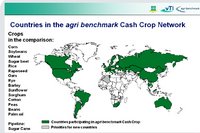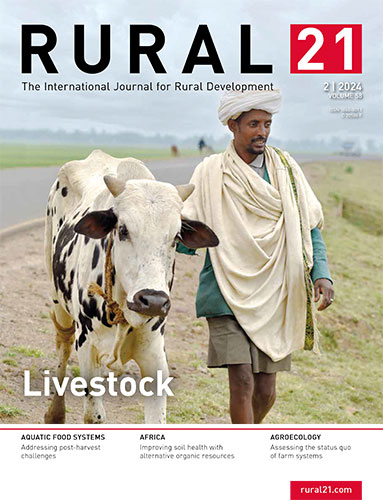- Share this article
- Subscribe to our newsletter
Appropriate agriculture can lessen the destructive impact of typhoons
 The ferocity of Typhoon Haiyan was unprecedented. It took the storm just two hours in the morning of November 8th, 2013 to reduce a stretch of land on the Philippine island of Leyte to rubble. Roofs were blown off, houses collapsed, and the whole infrastructure, including electricity and water supply, broke down. Coconut plantations were turned into a heap of snatched sticks. An entire landscape was turned upside down in the central pathway of the mega-typhoon.
The ferocity of Typhoon Haiyan was unprecedented. It took the storm just two hours in the morning of November 8th, 2013 to reduce a stretch of land on the Philippine island of Leyte to rubble. Roofs were blown off, houses collapsed, and the whole infrastructure, including electricity and water supply, broke down. Coconut plantations were turned into a heap of snatched sticks. An entire landscape was turned upside down in the central pathway of the mega-typhoon.
The more peripheral parts of the island of Leyte were hit hard, too. The majority of trees were defoliated. Along the roads, the avenues of mahogany and gmelina trees, originating from South America, and the Acacia species were severely harmed or even uprooted. Astonishingly, compared to the alien mahogany or gmelina trees, indigenous species, and in particular fruit trees, sustained much less damage, and fewer of them were uprooted.
From the climate change perspective, the number of very serious typhoons is expected to increase dramatically because the surface water of the Pacific Ocean will reach the critical temperature of 26 degree C. – the main cause for the formation of typhoons – more often. A mega-typhoon with wind velocities of up to 350 km/h can be compared to a volcanic eruption, a natural disaster prone to produce a calamity of catastrophic dimensions.
While global warming can only be stopped in a global effort, local factors like deforestation and destruction of the landscape and people’s habitats have also contributed to the catastrophe on the island of Leyte. Over the last ten decades, for example, most of the mangrove forests in the coastal regions were cleared, which meant that the tidal wave of Typhoon Haiyan could hit the coastal areas unchecked. But typhoons do not simply whirl up the sea. They also carry heavy rainfall into the interior of the areas affected. Wherever the fragile soils are not protected by dense vegetation, there is a danger of landslides. Leyte has experienced a number of devastating landslides over the last 15 years. Around 1,800 people died in the most momentous disaster in 2004.
In order to protect areas against the destructive impact of typhoons, it is vital to maintain or reforest both the green protective belt along the coasts and the rainforests on mountain slopes. The local population have to be integrated in these measures right from the start. For without agricultural alternatives, and without an alternative source of firewood, deforestation will remain an essential element of survival.
Protecting the coastal and inner landscapes with agroforestry approaches
A method to improve the livelihood situation of the rural poor, while getting back the ecological functions of a landscape, including the improvement of local biodiversity has been developed over the last 20 years in a joint project between the University of Hohenheim, Stuttgart, Germany, and Visayas State University in Leyte. It is called “Rainforestation Farming” and is a kind of agroforestry approach with a very strong emphasis on the use of indigenous tree species only.
The removal of mangrove forest has to be stopped if entire stretches of coastal areas are not to be lost in a very short time and coastal fisheries are to survive, because the nursery grounds for fish fingerlings vanishes with the mangroves. The rehabilitation of degraded former mangrove areas is a must, and the dams of all former abandoned pond areas need to be opened to let floating mangrove seeds re-colonise the swampy area. In addition, active mangrove rehabilitation with mangrove seedlings, if possible from nearby areas, has to be performed in co-operation with the coastal communities.
A second approach that has already yielded promising results on about 28 farms on Leyte and on other Philippine islands like Bohol and Mindanao, features the creation of mixed cultures comprising indigenous fruit trees and tropical coppices that can be combined with a special form of smallholder farming. A wide range of plants growing in shaded habitats, such as spice plants or fibre bananas, which can be grown between trees in mixed woodland, are suitable for these mixed cultures. In addition to fruit-growing, these products could also be increasingly developed as a source of income for smallholders in the future. And the “Grow your own Firewood” programme planned by the Forest Department of Visayas State University could contribute to checking deforestation. It aims to help village communities create their own supplies of firewood with fast-growing indigenous tree and hedge species.
Both of the projects run by Visaya State University are supported by Naturelife International in cooperation with the University of Hohenheim. They are a possible answer to the problem of reducing the vulnerability of the rural people and fisherfolk not only in the Philippines, but also in other South and South East Asian countries.
Details of the collaborative research programme with Visayas State University and the University of Stuttgart-Hohenheim
The co-operation agreement between Visayas State University (VSU) and the University of Hohenheim was signed in 1999. In a two-year “consultancy” programme conducted in the context of the Biodiversity Quality Network supported by the German Academic Exchange Service (DAAD), they developed teaching and research contents were elaborated from 2010 to 2 already developed teaching and research contents were elaborated from 2010 to 2012. One of the results of co-operation is the further development of the newly established MSc in Ecology Programme run by VSU and the elaboration and dissemination of Rainforestation Farming Technology.
The NatureLife-International Foundation, based in Ludwigsburg, Germany, has already been implementing the “Rainforestation Farming” method in selected model projects in Leyte and other regions in South East Asia for several years.
Prof. Dr. Friedhelm Göltenboth is Honorary Professor at the University of Hohenheim, Stuttgart, Germany, a Member of the University’s Centre for Agriculture in the Tropics and Subtropics, and a scientific consultant for the NatureLife-International Foundation.
E-Mail: friedgoelten@gmx.de



Add a comment
Be the First to Comment